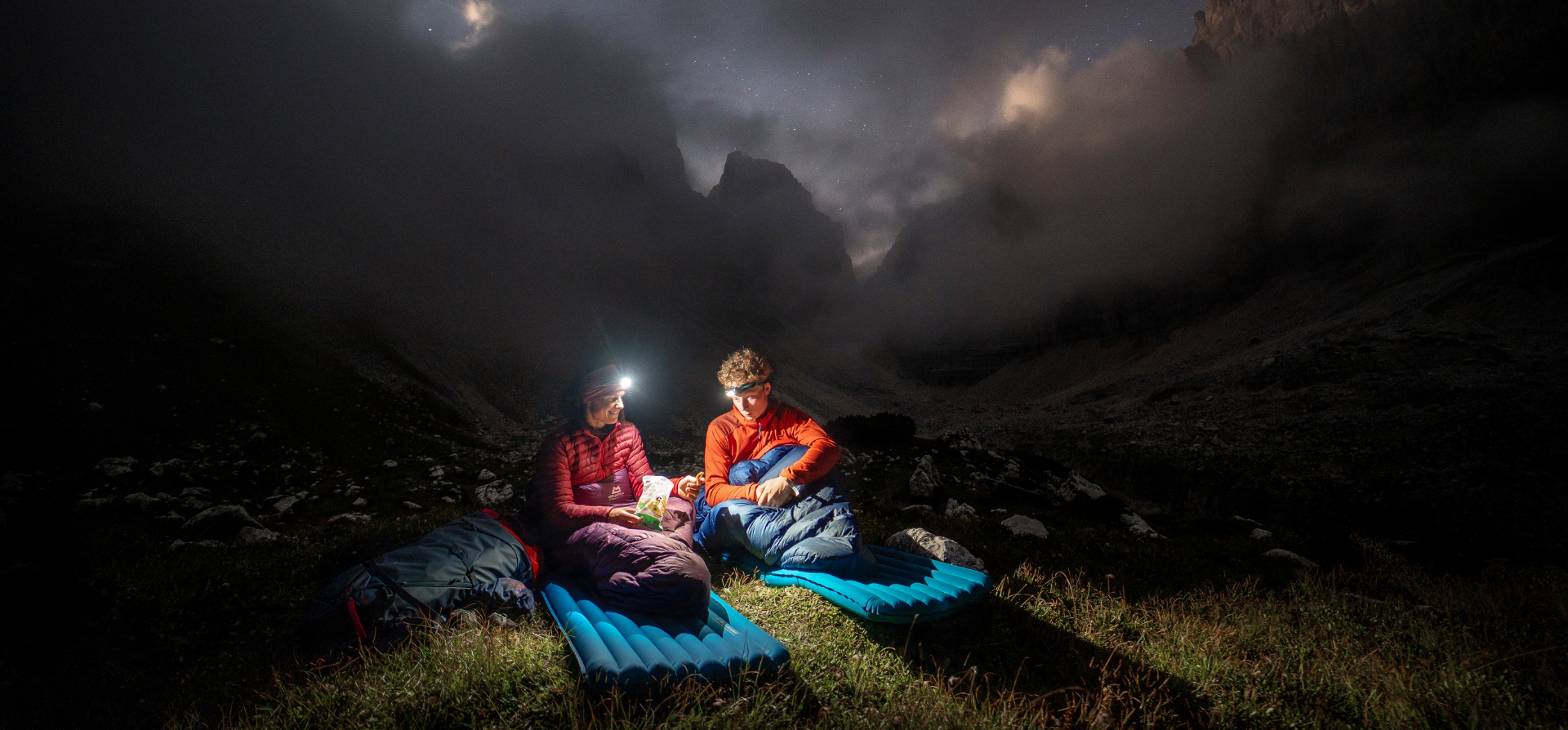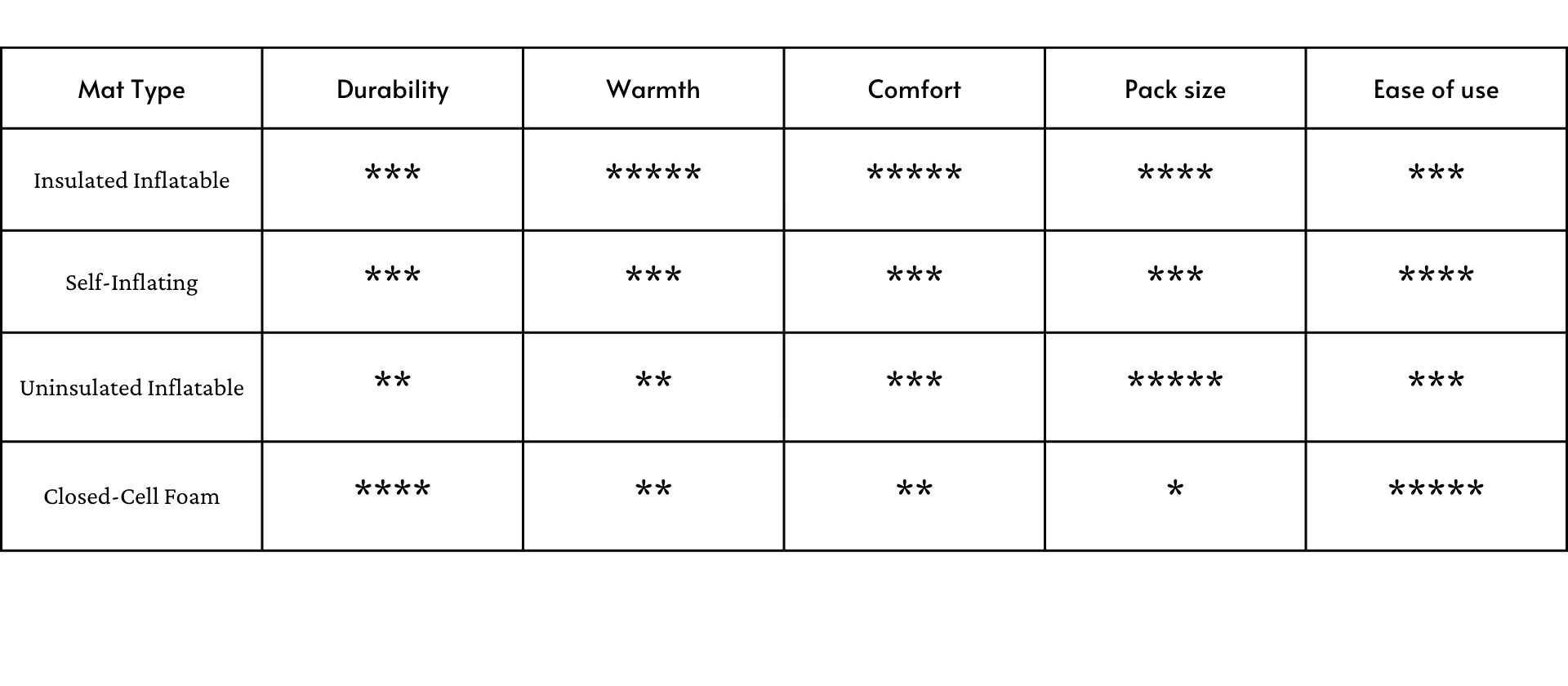Feeling strong and ready for a big day ahead or recovering after a long route requires good sleep, and a sleeping mat is essential for that. Suddenly, even the most remote and inaccessible camp can be made to feel comfortable.
The ground conducts heat up to 60 times faster than air, and if sleeping on ice that it increases to 90 times. That means a huge amount of heat can be lost to the ground, and a sleeping mat helps negate that.
A test worth trying is to use a warm sleeping mat instead of a regular one and see how much lighter a sleeping bag you can get away with. Often the resultant combination of mat and bag is lighter, and more comfortable too.
Types of sleeping mat
There are four main types of sleeping mats, each with their own characteristics.
-
Closed-Cell Foam Mats
These are a classic benchmark product recognised by hikers and mountaineers across the generations. They provide an extremely durable and relatively inexpensive option which is crampon-proof, lightweight, and completely idiot proof. But they’re also really uncomfortable.
Foam mats remain a common sight strapped to the packs of alpinists on big routes, and we would recommend them for many alpine bivvies, or in scenarios where mat failure is likely and would result in serious consequences.
As well as lacking comfort they don’t fold up very small and provide precious little insulation. For certain situations they are still hard to beat, but for many applications there are now better options available than the closed-cell foam mat. -
Uninsulated Inflatable Mats
Essentially using air mattress technology, these mats are phenomenally lightweight and relatively comfortable, but they lack any real insulation and are quite vulnerable to puncture. When low weight is critical and in applications where mat failure is not disastrous (for example, some adventure races or mountain marathons) they are a good option, and we ourselves have used them regularly, but we would not recommend these mats for most applications unless you’re obsessed with saving weight.
We once made a sleeping bag which was Balloonbed compatible: it had fabric tubes running along its length which were then filled with long modelling balloons. The resultant bag/mat combination was extremely light and relatively comfortable, but the sound of bursting balloons during overnight camps at Mountain Marathons defined some competitors’ experiences. -
Insulated Inflatable Mats
These mats offer the greatest performance across most metrics. They are the warmest option, they are very light, they are exceptionally comfortable, and they pack up very small. Their limitations are their relatively high price, and the risk of puncture (though this is seldom as much a problem as many people expect). For cold-weather camping, for weight conscious users, or for those to whom comfort is key, this is the best sleeping mat option available.
-
Self-Inflating
These are another veteran and iconic product. They use foam to pull air into them (‘self-inflating’) and then a little air is used to top them up and increase the pressure. Self-inflating mats are significantly more comfortable than closed-cell foam mats, they are warmer, and weigh only a little more. They are easy to use and pretty durable, and pack up much smaller than a foam mat too. However, self-inflating mats can puncture and lack the real intense warmth and comfort of an insulated mat. They are a good all-round option for many campers, but are no longer the highest-performing option available.
Sleeping Mat Performance by Type
Sleeping Mat Construction
We make both self-inflating mats and insulated inflatable mats. Self-inflating mats use a foam core and air to support them, while insulated inflatable mats use air to support them and internal baffles to prevent the mat expanding too much.
-
Self-Inflating Mats
In self-inflating mats, foam is used as both structure and as an insulation. Foam is an excellent insulator but relatively heavy and bulky compared to down or synthetic insulation, which is why these mats tend to be less warm for their weight than our Aerostat mats.
-
Insulated Inflatable Mats
In our Aerostat 7.0 Synthetic Mat, sheets of Polarloft® synthetic insulation are stretched from the top to the bottom of each mat to prevent convection occurring inside the mat, and to minimise radiation of heat. Our Polarloft® insulation provides reliable durable warmth far in excess of that offered by the foam in self-inflating mats. It is also resistant to moisture and extremely durable. Our Aerostat Down mats use 700 fill power down insulation held inside the mat. Down is an exceptional insulator which has the highest warmth-to-weight ratio of all known fibrous materials. However, the difficulty with down is that it likes to move around if not kept in place. As a result we have used our unique Helix™ Baffle to reduce down migration and to ensure the mat is warm throughout its length. This results in one of the warmest sleeping mats available.
Aerostat Mat Construction
Aerostat mats are welded together, and most of the construction is kept inside the mat, away from damage. We use technology patented by Exped® and licensed by us to ensure that the insulation can never escape the mat: foam plugs are used in the end of the mat to resist insulation leaving the mat, and these are welded into the mat.
Our custom-moulded Gas Mask valve is 2-way and allows a user to inflate their mat without fear of air escaping, but it also allows the user to dump air out quickly when it’s time to strike camp. While an inflatable mat is not as durable as a foam mat, we have used very durable 30D fabrics with coatings that are highly resistant to hydrolysis to create mats that should last for many years. These little details result in the finest sleeping mats that we’ve ever made.

Sleeping Mat Temperature Rating
What is an R-value?
R-values measures how warm a sleeping mat feels. ‘R’ refers to thermal resistance, and a greater R-value means a warmer mat. Until very recently there was no universal test for assessing a mat’s warmth, making direct comparison between the R-values from different manufacturers difficult, but in 2018 publication of ASTM F3340, a Standard test for sleeping mats, greatly improved this situation. Our Aerostat mats are all tested using ASTM F3340.
Your Sleeping System is Key
Sleeping mats are often overlooked when thinking about sleep systems in favour of more immediately appealing sleeping bags. However, sleeping mats influence how warm, comfortable and rested you can feel, as well as how much weight you carry and how big your bag must be. Think about everything you are using including your bag, mat, and where you are sleeping to ensure you’re going to be warm enough. Using a warm sleeping mat means that you can sometimes carry a lighter sleeping bag, and the result is often lighter and more comfortable than using a thin mat and a warm bag.

Sustainability
Sleeping mats are energy-intensive products to manufacture and, being composed of multiple different parts, difficult to recycle at the end of their life. Little to no impact occurs in their ‘use’ phase – unlike with for example clothing, which uses energy and water when it is washed – but the user is still essential to sustainability when it comes to a sleeping mat. Looking after your sleeping mat, caring for it, repairing it when necessary, and not replacing it until you really have to play a huge part in minimising a sleeping mat’s product impact. We are working hard to reduce the impact of manufacture and are exploring numerous options for this, from recycled fabrics and fill, to dope-dyed fabrics, more durable materials and processes, to minimising the impact of shipping.










